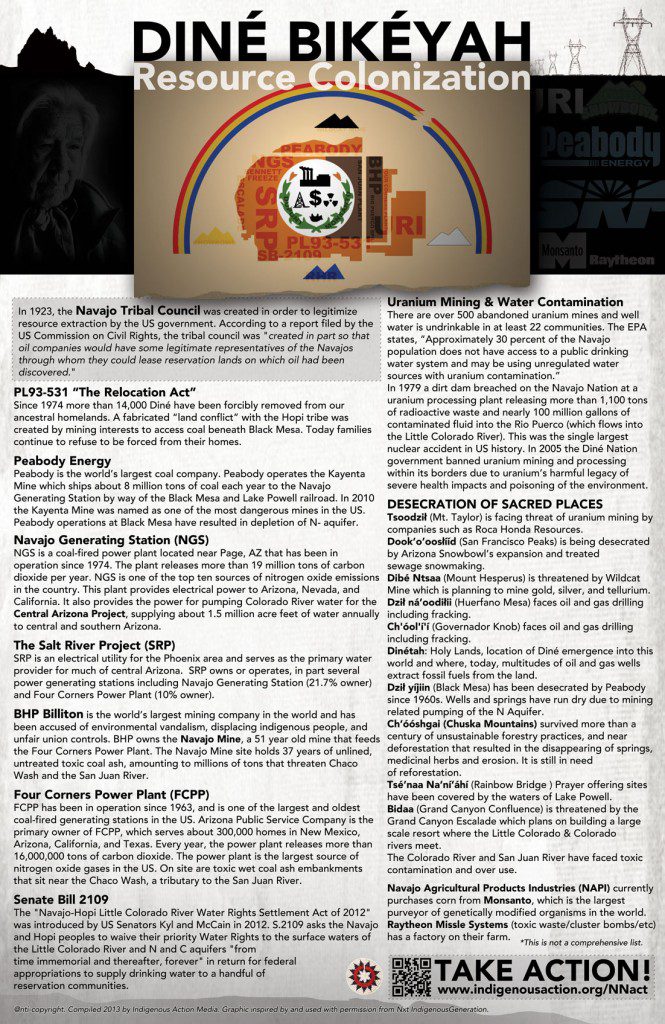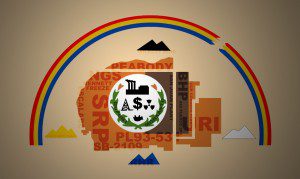#NNact » Diné Bikéyah (Navajo Nation) Resource Colonization
[vc_row][vc_column][vc_column_text]

Those with 501c3 status or fiscal sponsors can get posters for $15 for 50 (cost of shipping). We hope you use funds raised from this poster project to directly support your efforts (gas money, food, rent, cell phone, etc). We will not profit from this project, all our work is donated. If we make enough funds from donations we will reprint them.
Printed with vegetable oil based inks, recycled paper and union labor by Inkworks Press.
TAKE ACTION!
Share your updates, news, and actions:#NNact
Organize. Contact the groups listed below & connect with their campaigns or organize one of your own! (updates in progress)
Direct Action. Form an affinity group, determine strategic points of intervention, choose your tactics… read more here.
[mkd_separator class_name=”” type=”full-width” position=”center” color=”black” border_style=”” width=”” thickness=”” top_margin=”” bottom_margin=””]
ORGANIZATION & INDIVIDUAL DIRECTORY
Email us at indigenousaction@gmail.com to add your contact.
NAME: Diné CARE
CONTACT: Diné CARE Main Office: 63 Box 263, Winslow, AZ 86047. Telephone: (928) 380-7697
Durango Office: 10A Town Plaza, Suite 138, Durango, CO 81301. (970) 259-0199
WEBSITE: www.creativegeckos.com/dinecare/
DESCRIPTION: Diné CARE is located on the Navajo Nation and is a non-profit organization that works with many Navajo communities affected by energy and environmental issues. Since the late 1980s, community people have stood up and demanded for environmental protection and sustainable development practices, bringing systemic changes in tribal politics and making the grassroots voices evident in the realm of energy development.
NAME: Multicultural Alliance for a Safe Environment
CONTACT: masecoalition2008@gmail.com, 505-240-3104
WEBSITE: www.masecoalition.org
DESCRIPTION: MASE is rooted in the experiences of uranium-impacted communities of the southwestern U.S. We are communities working to restore and protect the natural and cultural environment through respectfully promoting intercultural engagement among communities and institutions for the benefit of all life and future generations.
NAME: Anna Marie Rondon
CONTACT: annarondon@msn.com, 505-879-8358, P.O. Box 5058 Gallup, NM 87305
DESCRIPTION: Works on uranium issues, green lifeways (economics) from Original Teachings, Networking and Coalition Building. Training on Community Based Land use Planning and mentoring youth.
[mkd_separator class_name=”” type=”full-width” position=”center” color=”black” border_style=”” width=”” thickness=”” top_margin=”” bottom_margin=””]
Diné Bikéyah: Resource Colonization
*This is not a comprehensive list but intended as an introductory guide
In 1923, the Navajo Tribal Council was created in order to legitimize resource extraction by the US government. According to a report filed by the US Commission on Civil Rights, the tribal council was “created in part so that oil companies would have some legitimate representatives of the Navajos through whom they could lease reservation lands on which oil had been discovered.”
PL93-531 “The Relocation Act”
Since 1974 more than 22,000 Diné have been forcibly removed from our ancestral homelands. A fabricated “land conflict” with the Hopi tribe was created by mining interests to access coal beneath Black Mesa. Big Mountain range lies at the center where, today, a large number of families continue to refuse to be forced from their homes. Big Mountain also holds an ancient Dineh shrine atop its summits for which Dineh have refuse to abandon. More info & action: www.blackmesais.org
Peabody Energy
Peabody is the world’s largest coal company. Peabody operates the Kayenta Mine which ships about 8 million tons of coal each year to the Navajo Generating Station by way of the Black Mesa and Lake Powell railroad. In 2010 the Kayenta Mine was named as one of the most dangerous mines in the US. Peabody operations at Black Mesa have resulted in depletion of N- aquifer. (www.peabodyenergy.com, www.sourcewatch.org/index.php/Kayenta_Mine, www.nrdc.org/water/conservation/draw/drawinx.asp)
Navajo Generating Station (NGS)
NGS is a coal-fired power plant located near Page, AZ that has been in operation since 1974. The plant releases more than 19 million tons of carbon dioxide per year. NGS is one of the top ten sources of nitrogen oxide emissions in the country. This plant provides electrical power to Arizona, Nevada, and California. It also provides the power for pumping Colorado River water for the Central Arizona Project, supplying about 1.5 million acre feet of water annually to central and southern Arizona. (www.srpnet.com/about/stations/navajo.aspx, www.epa.gov/region9/mediacenter/ngs/, www.sourcewatch.org/index.php?title=Navajo_Generating_Station)
The Salt River Project (SRP)
SRP is an electrical utility for the Phoenix area and serves as the primary water provider for much of central Arizona. SRP owns or operates, in part several power generating stations including Navajo Generating Station (21.7% owner) and Four Corners Power Plant (10% owner).
BHP Billiton is the world’s largest mining company in the world and has been accused of environmental vandalism, displacing indigenous people, and unfair union controls. BHP owns the Navajo Mine, a 51 year old mine that feeds the Four Corners Power Plant. The Navajo Mine site holds 37 years of unlined, untreated toxic coal ash, amounting to millions of tons that threaten Chaco Wash and the San Juan River.
Four Corners Power Plant (FCPP)
FCPP has been in operation since 1963, and is one of the largest and oldest coal-fired generating stations in the US. Arizona Public Service Company is the primary owner of FCPP, which serves about 300,000 homes in New Mexico, Arizona, California, and Texas. Every year, the power plant releases more than 16,000,000 tons of carbon dioxide. The power plant is the largest source of nitrogen oxide gases in the US. On site are toxic wet coal ash embankments that sit near the Chaco Wash, a tributary to the San Juan River.
Senate Bill 2109
The “Navajo-Hopi Little Colorado River Water Rights Settlement Act of 2012” was introduced by US Senators Kyl and McCain in 2012. S.2109 asks the Navajo and Hopi peoples to waive their priority Water Rights to the surface waters of the Little Colorado River and N and C aquifers “from
time immemorial and thereafter, forever” in return for federal
appropriations to supply drinking water to a handful of
reservation communities.
Uranium Mining & Water Contamination
There are close to 2,000 abandoned uranium mines and well water is undrinkable in at least 22 communities.
The EPA states, “Approximately 30 percent of the Navajo population does not have access to a public drinking water system and may be using unregulated water sources with uranium contamination.”
In 1979 a dirt dam breached on the Navajo Nation at a uranium processing plant releasing more than 1,100 tons of radioactive waste and nearly 100 million gallons of contaminated fluid into the Rio Puerco (which flows into the Little Colorado River). This was the single largest nuclear accident in US history. In 2005 the Diné Nation government banned uranium mining and processing within its borders due to uranium’s harmful legacy of severe health impacts and poisoning of the environment.
DESECRATION OF SACRED PLACES
Tsoodził (Mt. Taylor) is facing threat of uranium mining by companies such as Roca Honda Resources.
Dook’o’oosłííd (San Francisco Peaks) is being desecrated by Arizona Snowbowl’s expansion and treated
sewage snowmaking.
Dibé Ntsaa (Mount Hesperus) is threatened by Wildcat Mine which is planning to mine gold, silver, and tellurium.
Dził ná’oodiłii (Huerfano Mesa) faces oil and gas drilling including fracking.
Ch’óol’í’í (Governador Knob) faces oil and gas drilling including fracking.
Dinétah: Holy Lands, location of Diné emergence into this world and where, today, multitudes of oil and gas wells extract fossil fuels from the land.
Dził yíjiin (Black Mesa) has been desecrated by Peabody since 1960s. Wells and springs have run dry due to mining related pumping of the N Aquifer.
Ch’óóshgai (Chuska Mountains) survived more than a century of unsustainable forestry practices, and near deforestation that resulted in the disappearing of springs, medicinal herbs and erosion. It is still in need
of reforestation.
Tsé’naa Na’ní’áhí (Rainbow Bridge ) Prayer offering sites have been covered by the waters of Lake Powell.
Bidaa (Grand Canyon Confluence) is threatened by the Grand Canyon Escalade which plans on building a large scale resort where the Little Colorado & Colorado
rivers meet.
The Colorado River and San Juan River have faced toxic contamination and over use.
Navajo Agricultural Products Industries (NAPI) currently purchases corn from Monsanto, which is the largest purveyor of genetically modified organisms in the world. Raytheon Missle Systems (toxic waste/cluster bombs/etc) has a factory on their farm.
@nti-copyright. Compiled 2013 by Indigenous Action Media. Graphic inspired by and used with permission from Nxt IndigenousGeneration.
[/vc_column_text][/vc_column][/vc_row][vc_row][vc_column width=”1/4″][vc_facebook type=”button_count”][/vc_column][vc_column width=”1/4″][vc_googleplus][/vc_column][vc_column width=”1/4″][vc_tweetmeme share_via=”media_action” share_hashtag=”nnact”][/vc_column][vc_column width=”1/4″][vc_pinterest][/vc_column][/vc_row]


Get updates via email, sign up here:


Indigenous Action Podcast
- Indigenous Action Podcast Ep. 18: No Settler Future An Anti-Year in Review (sorta)
- Indigenous Action Podcast Episode 17: Decolonization isn’t a Holiday
- Indigenous Action Podcast Episode 16: Fuck a Valentine, Indigenous Abolition Feminism
- Indigenous Action Podcast Episode 15: 15th Annual No Thanks, No Giving: Indigenous Anarchism
- Indigenous Action Podcast Episode 14: Queering #MMIWG2ST

